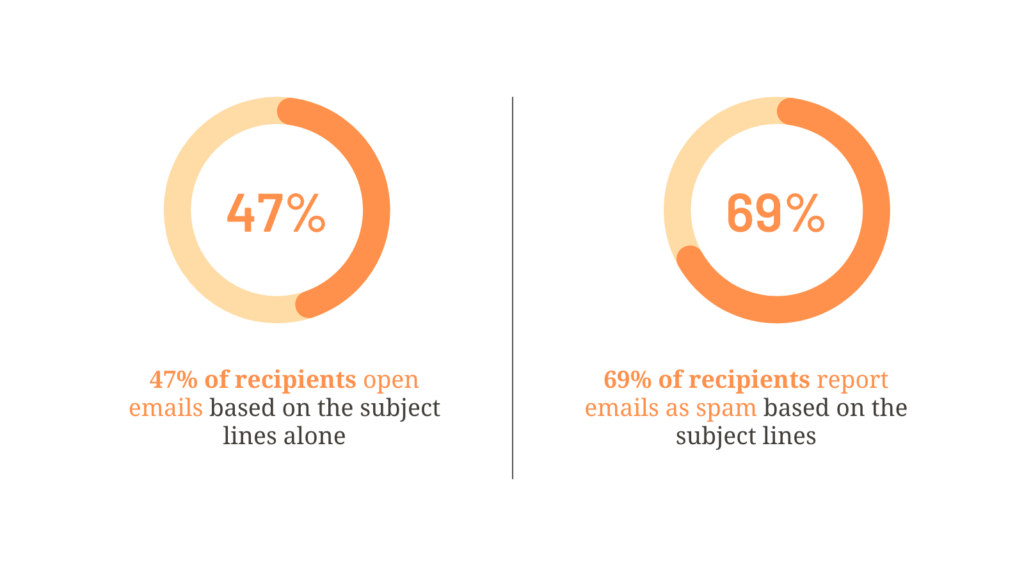In today’s interconnected world, networking has become an indispensable tool for personal and professional growth. While writing good email copies is essential to building connections, crafting outstanding networking subject lines is crucial to getting those emails opened.
According to OptinMonster:

Whether you’re looking to establish new connections, rekindle old ones, or seek advice from industry experts, the art of crafting attention-grabbing email subject lines for networking can make all the difference.
In this post, we’ll delve into why networking email subject lines are crucial and provide you with some examples to supercharge your outreach efforts.
Table Of Contents
1. Why crafting good email subject lines for networking is crucial?
2. Best practices for writing a networking email subject line
3. 30 networking email subject line examples
3.1 Subject line for cold email networking
3.2 Reconnection networking emails
3.3 Follow-up networking emails
3.4 Asking for advice
3.5 Referencing the receiver’s work
3.6 Referencing a mutual connection
4. How SafeMailer can help your networking campaigns?
5. Conclusion
6. FAQs
Why crafting good email subject lines for networking is crucial?
Picture this: Your inbox is overflowing with plenty of emails. Here, your email subject lines serve as the initial point of contact and influence whether your email will be opened or ignored.

A well-crafted subject line grabs the recipient’s attention, arouses curiosity, and sets the tone for the interaction that follows. It’s your first impression encapsulated in a few words.
Best practices for writing a networking email subject line
Clarity and Conciseness
Networking email subject lines should be clear and to the point. So, make sure to avoid ambiguity and ensure that recipients can quickly grasp the purpose of the email.
Personalization
Incorporate the recipient’s name or reference-specific details to make the networking email subject line more personalized. This can grab their attention and increase the likelihood of the email being opened.
Relevance
Ensure that the networking email subject line is directly related to the content of the email. Misleading subject lines can lead to frustration and may result in your emails being marked as spam.
Highlight Value
Clearly communicate the value or benefit the recipient will gain by opening the email. Whether it’s an opportunity, information, or a request, make it evident in the subject line.
Action-oriented Language
Use action verbs to inspire a sense of urgency or motivation. Words like “Discuss,” “Join,” or “Explore” can encourage recipients to engage with the email promptly.
Avoid Spam Trigger Words
Steer clear of words and phrases that are commonly associated with spam, as they might trigger spam filters. Examples include “free,” “urgent,” or excessive use of exclamation marks.
Mindful Length
Keep subject lines within a reasonable length to ensure they are fully visible on various devices. Aim for around 6-10 words to maintain clarity and encourage quick comprehension.

A/B Testing
Experiment with different subject lines to see what resonates best with your audience. Utilize A/B testing to analyze open rates and refine your approach for future emails.
30 networking email subject line examples
Wondering what to subject an email for networking? Here we have enlisted 30 email subject lines networking examples.
1. Subject line for cold email networking
You’re reaching out to someone new, hoping to forge a connection. The key here is personalization. Show that you’ve done your homework, and your subject line can open doors you never thought possible.
For instance, “Inspired by Your Work at [Event/Project]”
This subject line shows that you’ve done your research by referencing a specific event or project the recipient was involved in. It conveys genuine interest and sets a positive tone for the email.
Here are some more cold email subject line networking examples:
- “Let’s Connect and Make Magic Happen, #Recipient’s Name#!”
- “Hi #Recipient’s Name#, Can We Explore Opportunities Together?”
- “Breaking the Ice: #Your Name# Here, Eager to Chat!”
- “A New Connection for New Ventures: It’s #Your Name#!”
- “Open to Possibilities: #Your Name# Interested in #Recipient’s Expertise#”
2. Reconnection networking emails
Rekindling old connections requires a delicate touch. Make the recipient feel cherished and excited about catching up. A nostalgic yet forward-looking subject line can rekindle the flames of friendship and collaboration.
For example, “Reflecting on Great Times: Let’s Catch Up!”
This subject line combines a sense of nostalgia with a forward-looking perspective. It implies that you value the past relationship and are excited about reconnecting in the present and future.
Also, refer to these examples of networking email subject lines
- “Reuniting with an Old Pal: Catching Up, #Recipient’s Name#?”
- “Guess Who’s Back? #Your Name# Wants to Reconnect!”
- “From Good Old Days to Bright New Futures: Let’s Chat, #Recipient’s Name#!”
- “Rediscovering Connections: #Your Name# Checking In!”
- “Remember Me? #Your Name# – Let’s Catch Up, #Recipient’s Name#!”
3. Follow-up networking emails
After an initial interaction, keeping the momentum going is vital. Your subject line should echo your previous conversation and promise value in the next steps. This shows professionalism and genuine interest.
For instance, “Building on Our Conversation: Next Steps”
This subject line acknowledges the previous interaction and signals continuity. It shows professionalism and communicates that you are ready to move forward in your collaboration or conversation.
Here are some more networking email subject line examples:
- “Our Conversation Continues: #Your Name# Here with Updates”
- “Remember Our Talk? #Your Name# Following Up with More”
- “Taking Next Steps: #Your Name#’s Follow-Up from #Event/Meeting#”
- “Moving Forward Together: #Your Name#’s Post-#Event/Meeting# Update”
- “Let’s Keep This Going: #Your Name#’s Follow-Up After #Event/Meeting#”
Related: Top follow up email subject lines
4. Asking for advice
Seeking advice from someone you admire requires expertise. Your subject line should signal respect for their expertise and indicate a clear ask, making them more likely to engage.
For example, “Respecting Your Expertise: Seeking Guidance”
This subject line conveys respect for the recipient’s knowledge and positions the email as a request for valuable advice. It’s clear and sets the expectation that you value their expertise.
Check these examples of networking email subject lines too
- “Seeking Your Insights: Can You Help, #Recipient’s Name#?”
- “In Need of Wisdom: #Your Name#’s Question for You”
- “Expertise Needed: #Your Name# Would Love Your Thoughts”
- “Can I Pick Your Brain? #Your Name#’s Inquiry Inside”
- “Your Experience Counts: #Your Name# Seeking Advice on #Specific Challenge#”
5. Referencing the receiver’s work
Flattery can get you everywhere, especially when it’s genuine. Reference a recent accomplishment of the recipient and tie it into a potential collaboration, showing that you’re not just interested but invested.
For example, “Impressed by Your Recent [Accomplishment]”
This subject line directly acknowledges a recent achievement of the recipient, expressing genuine admiration. It smoothly transitions into a potential collaboration by linking their accomplishment to shared interests.
Have a look at these networking email subject line examples too
- “Cheers to Your Success, #Recipient’s Name#! Let’s Collaborate”
- “Impressed by Your Achievements: #Your Name# Interested in Teamwork”
- “Your Work Inspires: #Your Name# Has an Idea for You”
- “Noticed Your Impact: #Your Name#’s Proposal Inside”
- “Recognizing Excellence: #Your Name#’s Vision for #Recipient’s Expertise#”
6. Referencing a mutual connection
Common ground is the bedrock of networking. Mentioning a mutual connection in your subject line establishes rapport and increases the likelihood of your email being welcomed warmly.
For instance, “Connecting Through [Mutual Connection’s Name]”
By mentioning a mutual connection in the subject line, you establish common ground immediately. It makes the email more personal and increases the likelihood that the recipient will open it with a sense of familiarity and warmth.
Here are some more networking email subject line examples
- “Through a Friend: #Mutual Contact’s Name# Thought We’d Click, #Recipient’s Name#!”
- “It’s a Small World: #Mutual Contact’s Name# Linked Us, #Recipient’s Name#!”
- “From #Mutual Contact’s Name#’s Circle: #Your Name# Reaching Out”
- “A Common Link: #Mutual Contact’s Name# Says We Should Chat, #Recipient’s Name#!”
- “Friendship Connection: #Mutual Contact’s Name# Introduces #Your Name# to You, #Recipient’s Name#!”
How SafeMailer can help your networking campaigns?
In the fast-paced realm of networking, time is a precious resource. That’s where a cold email automation tool comes into play. Imagine the power to create personal connections and send out multiple connection requests seamlessly, all while retaining that genuine human touch.
Here’s how a cold email automation tool like SafeMailer can elevate your networking prowess:
- Tailored personalization: Insert placeholders for names, company details, and more within a hashtag syntax, giving each email that tailored feel, even when sent in bulk.
- Strategic timing: You can plan your outreach by scheduling emails to arrive at the most opportune moments, boosting the likelihood of them being noticed and opened. SafeMailer helps you tailor your sending pattern in a human-like manner thus boosting your deliverability rate.
- Insightful analytics: Gain insights into open rates, click-through rates, and responses. This data empowers you to refine your approach and comprehend what resonates.
- Crafted sequences: Set up personalized email sequences that guide recipients through a series of thoughtful interactions, nurturing a more profound connection over time.
Conclusion
Coming up with a good subject line for networking emails might seem hard, but it’s not too complicated.
However make sure that when creating a subject line for your networking email, keep it short, clear, and personal, and tell the recipient what you want them to do. You can refer to the above-mentioned examples.
Tools like SafeMailer can help you make your networking emails feel personal without doing it all manually. You can even A/B test your subject lines here and schedule your emails at the best time possible.
FAQs
Q. What elements make a good networking email subject line?
A: A good subject line is clear, concise, and relevant. It should convey the purpose of your email and entice the recipient to open it. Personalization and value proposition are also key components.
Q. Are there specific words or phrases to avoid in networking email subject lines?
A: Yes, avoid spam-trigger words like “urgent,” “free,” or excessive use of punctuation. These may trigger spam filters and diminish the professionalism of your email.
Q. Should networking email subject lines be short or long?
A: Aim for a balance. Keep subject lines concise (6-10 words) to ensure clarity and visibility on various devices. Long subject lines may be overlooked, while overly short ones might lack context.
Q. How can I test the effectiveness of my networking email subject lines?
A: Use A/B testing by sending variations of your subject line to a small sample. Analyze open rates to determine which version resonates better with your audience.
Q. Is it important to consider mobile users when crafting subject lines?
A: Absolutely. Many people check emails on mobile devices. Ensure your subject lines are mobile-friendly, keeping them concise and impactful for smaller screens.
Q. Can I use humor in networking email subject lines?
A: Use caution. Humor can be subjective and may not always translate well in professional contexts. Ensure it aligns with the tone and expectations of your relationship with the recipient.
Q. How do I create a sense of urgency without sounding pushy?
A: Utilize action-oriented language and time-sensitive terms like “Limited time” or “Act now,” but strike a balance to maintain a professional tone and avoid being overly forceful.

Leave a Reply